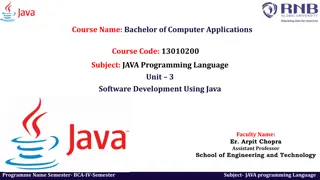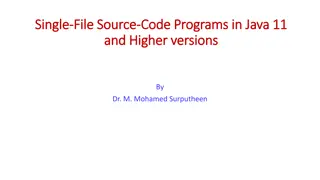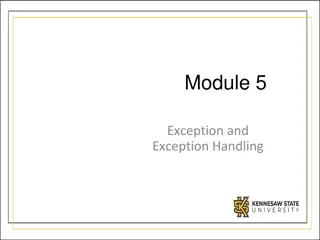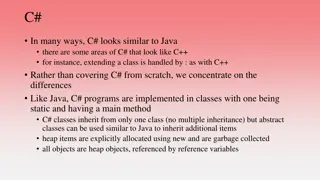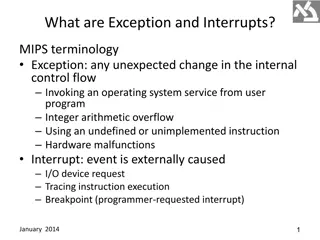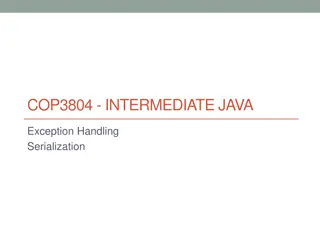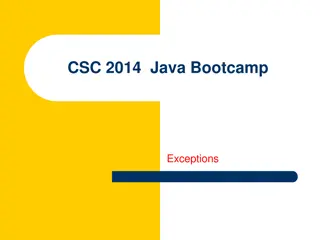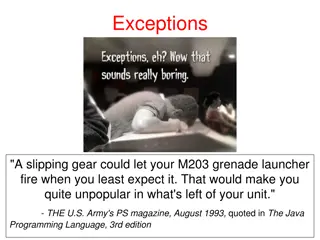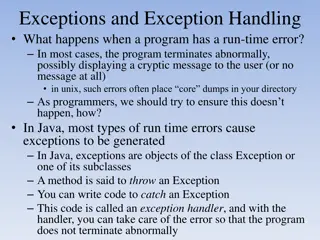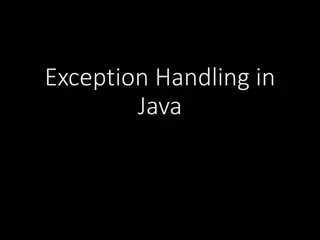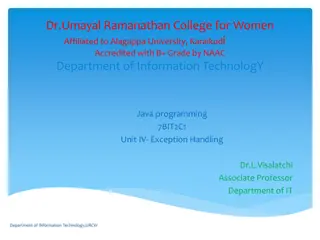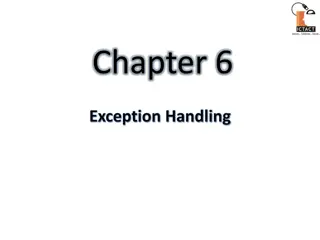Understanding Exception Handling in Java
Exception handling in Java is a crucial mechanism to manage runtime errors effectively. This article explains the concept of exceptions, advantages of using exception handling, types of exceptions (checked, unchecked, and errors), common scenarios like ArithmeticException and NullPointerException, and the role of exception handling in maintaining the normal flow of an application. By handling exceptions, you can ensure the continued execution of code even when errors occur, improving the reliability and robustness of your Java programs.
Download Presentation

Please find below an Image/Link to download the presentation.
The content on the website is provided AS IS for your information and personal use only. It may not be sold, licensed, or shared on other websites without obtaining consent from the author. Download presentation by click this link. If you encounter any issues during the download, it is possible that the publisher has removed the file from their server.
E N D
Presentation Transcript
Dictionary Meaning: Exception is an abnormal condition. Exception Handling is a mechanism to handle runtime errors such as ClassNotFound, IO, SQL, Remote etc. Advantage The core advantage of exception handling is to maintain the normal flow of the application. Exception normally disrupts the normal flow of the application that is why we use exception handling. Let's take a scenario: Advantage of of Exception Exception Handling Handling 3
Cont statement 1; statement 2; statement 3; statement 4; statement 5;//exception occurs statement 6; statement 7; statement 8; statement 9; statement 10; Suppose there is 10 statements in your program and there occurs an exception at statement 5, rest of the code will not be executed i.e. statement 6 to 10 will not run. If we perform exception handling, rest of the statement will be executed. That is why we use exception handling in java. 4
There are mainly two types of exceptions: checked and unchecked where error is considered as unchecked exception. The sun microsystem says there are three types of exceptions: Checked Exception Unchecked Exception Error 1. 2. 3. 6
1) Checked Exception The classes that extend Throwable class except RuntimeException and Error are known as checked exceptions e.g.IOException, SQLException etc. Checked exceptions are checked at compile-time. 2) Unchecked Exception The classes that extend RuntimeException are known as unchecked exceptions e.g. ArithmeticException, NullPointerException, ArrayIndexOutOfBoundsException etc. Unchecked exceptions are not checked at compile-time rather they are checked at runtime. 3) Error Error is irrecoverable e.g. OutOfMemoryError, VirtualMachineError, AssertionError etc. 7
1) Scenario where ArithmeticException occurs If we divide any number by zero, there occurs an ArithmeticException. int a=50/0;//ArithmeticException 2) Scenario where NullPointerException occurs If we have null value in any variable, performing any operation by the variable occurs an NullPointerException String s=null; System.out.println(s.length());//NullPointerException 8
3) Scenario where NumberFormatException occurs The wrong formatting of any value, may occur NumberFormatException. Suppose I have a string variable that have characters, converting this variable into digit will occur NumberFormatException String s="abc"; int i=Integer.parseInt(s);//NumberFormatException 4) Scenario where ArrayIndexOutOfBoundsException occurs If you are inserting any value in the wrong index, it would result ArrayIndexOutOfBoundsException as shown below: int a[]=new int[5]; a[10]=50; //ArrayIndexOutOfBoundsException 9
There are 5 keywords used in java exception handling. 1.try 2.catch 3.finally 4.throw 5.throws 10
Java try block Java try block is used to enclose the code that might throw an exception. It must be used within the method. Java try block must be followed by either catch or finally block. Syntax of java try-catch try{ //code that may throw exception } catch(Exception_class_Name ref){} Syntax of try-finally block try{ //code that may throw exception }finally{} 11
Java catch block is used to handle the Exception. It must be used after the try block only. You can use multiple catch block with a single try. public class TestMultipleCatchBlock{ public static void main(String args[]){ try{ int a[]=new int[5]; a[5]=30/0; } catch(ArithmeticException e){System.out.println("task1 is completed");} catch(ArrayIndexOutOfBoundsException e){System.out.println("task 2 completed");} catch(Exception e){System.out.println("common task completed");} System.out.println("rest of the code..."); } } 12
Java finally block is a block that is used to execute important code such as closing connection, stream etc. Java finally block is always executed whether exception is handled or not. Java finally block must be followed by try or catch block. class TestFinallyBlock { public static void main(String args[]){ try{ int data=25/5; System.out.println(data); } catch(NullPointerException e){System.out.println(e);} finally{System.out.println("finally block is always executed");} System.out.println("rest of the code..."); } } 13
Case 1 Let's see the java finally example where exception doesn't occur. class TestFinallyBlock { public static void main(String args[]) { try{ int data=25/5; System.out.println(data); } catch(NullPointerException e){System.out.println(e);} finally{System.out.println("finally block is always executed");} System.out.println("rest of the code..."); } } Output: finally block is always executed rest of the code... 14
Case 2 Let's see the java finally example where exception occurs and not handled. class TestFinallyBlock1 { public static void main(String args[]) { try{ int data=25/0; System.out.println(data); } catch(NullPointerException e){System.out.println(e);} finally{System.out.println("finally block is always executed");} System.out.println("rest of the code..."); } } Output: finally block is always executed Exception in thread main java.lang.ArithmeticException:/ by zero 15
Case 3 Let's see the java finally example where exception occurs and handled public class TestFinallyBlock2 { public static void main(String args[]) { try{ int data=25/0; System.out.println(data); } catch(ArithmeticException e){System.out.println(e);} finally{System.out.println("finally block is always executed");} System.out.println("rest of the code..."); } } Output: Exception in thread main java.lang.ArithmeticException:/ by zero finally block is always executed rest of the code... 16
The Java throw keyword is used to explicitly throw an exception. We can throw either checked or uncheked exception in java by throw keyword. The throw keyword is mainly used to throw custom exception. We will see custom exceptions later. The syntax of java throw keyword:throw exception; public class TestThrow1 { static void validate(int age) { if(age<18) throw new ArithmeticException("not valid"); else System.out.println("welcome to vote"); } public static void main(String args[]) { validate(13); System.out.println("rest of the code..."); } } java throw keyword example Output: Exception in thread main java.lang.ArithmeticException:not valid 17
The Java throws keyword is used to declare an exception. It gives an information to the programmer that there may occur an exception so it is better for the programmer to provide the exception handling code so that normal flow can be maintained. Exception Handling is mainly used to handle the checked exceptions. If there occurs any unchecked exception such as NullPointerException, it is programmers fault that he is not performing check up before the code being used. Syntax of java throws return_type method_name() throws exception_class_name { //method code } 18
import java.io.IOException; class Testthrows1 { void m()throws IOException { throw new IOException("device error");//checked exception } void n()throws IOException { m(); } void p() { try{ n(); }catch(Exception e){System.out.println("exception handled");} } public static void main(String args[]) { Testthrows1 obj=new Testthrows1(); obj.p(); System.out.println("normal flow..."); } } Output: exception handled normal flow... 19
Java provides most of the errors but most of the times standard exception cannot handles most of the exceptions. Such exceptions are designed by the user itself. For example if we put date 30 to month February then we have error InvalidDateException, but not such kind of exception. A user defined exception class must extend Exception. General form is given below; class UserDefinedException extends Exception { // code } 20
1. Write a Java program to find the exception Marks Out of Bounds. Create a class student If the mark is greater than 100, it must generate the user defined exception called Mark Out of Bounds exception and throw it. 2. Write a Java program to find out maximum of array elements and check for array limit. (Use exception handling) 21
class MarksOutOfBoundsException extends Exception { public MarksOutOfBoundsException(String str) { super(str); } } class student { int marks; public student() { marks=0; } public student(int marks) { this.marks=marks; } public void checkMarks() throws MarksOutOfBoundsException { if(marks>100) { throw new MarksOutOfBoundsException("Invalid Marks"); } else { System.out.println("Marks: "+marks); } } Program 1 solution } public class throwsDemo { public static void main(String args[]) throws MarksOutOfBoundsException { student s=new student(101); s.checkMarks(); } } 22
import java.io.BufferedReader; import java.io.IOException; import java.io.InputStreamReader; public class myEceptionDemo { public static void main(String args[]) { int a[]=new int[5]; int max=0; BufferedReader b=new BufferedReader(new InputStreamReader(System.in)); try { System.out.println("enter the element"); for(int i=0;i<a.length;i++) { a[i]=Integer.parseInt(b.readLine()); } for(int i=0;i<5;i++) { if(a[i]>max) { max=a[i]; } } System.out.println("maximum number is: "+max); } catch(ArrayIndexOutOfBoundsException exp) { System.out.println("Out of the array limit..."); } catch(IOException e) { } } } Program 2 solution 23





